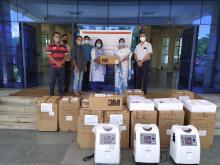The devastating tropical cyclone Nargis that struck southern Burma (Myanmar) two months ago, has revealed to the world that it was even less disastrous compared to its regime. The military regime, which not only ignored the difficulties faced by its own people after the disaster, but also restricted relief from international communities for them. The group of Generals, known as the State Peace and Development Council, had one apprehension that the massive flow of foreign aid workers to their country might create an ambiance for a major uprising against the government.
The deadly cyclone moved towards the Burmese land from the Bay of Bengal on the night of May 2, and it devastated the entire Irrawaddy and Rangoon divisions of the country. Nargis also embraced three other divisions and states (Bago, Mon and Kayin) and killed nearly ninety thousand people and made another few thousands homeless. It also left a trail of devastation on social infrastructures, killing thousands of livestock and also causing flood, destroying the paddy fields, which were made ready for Myanmar's primary crops rice.
According to the latest government information, made available with the government run daily newspaper 'The New Light of Myanmar', the storm killed 84,537 people, leaving 53,836 missing and 19,359 injured. The United Nations estimates that Nargis affected 2.4 million people and directly made thousands homeless. At the same time, over 3,00,000 water buffaloes and cows died in Irrawaddy delta and Yangon localities. Moreover, nearly 10,00,000 acres of farmland in Irrawaddy and 3,00,000 acres in Yangon division were destroyed. Over one million acres of fertile land were also flooded with the salty seawater.
But the response to the disaster by its own rulers was simply shocking. First, the rulers couldn't provide immediate relief to the victims and secondly, they tried to prevent (and restrict) the international aid for their very own people, who were in desperate need of food, medicine and shelter.
"The military regime at Nay Pyi Taw always remained blind to the political power and they can go to all extent to maintain it. Hence, they could ignore all the troubles faced by the cyclone victims. The State Peace and Development Council (SPDC) chief senior general, Than Shwe got time to visit those victims only after international criticism came out in a bigger way. Mind it, they can easily sacrifice the people, but never tolerate international access (through the aid workers) to its common people," commented a Yangon based opposition political leader, who wanted anonymity.
The callousness of the junta was also criticised by Suzanne DiMaggio, director of the Asia Society's Social Issues Programme (and former vice president of Global Policy Programmes at the United Nations Association of America) saying that for nearly five decades, Myanmar's military rulers had systematically undermined the interests of their own citizens. Referring to Narigs, she stated that the junta-controlled news media failed to announce warnings about the approaching cyclone.
"The entry of UN humanitarian personnel, has been delayed due to the government's refusal to allow aid workers into the country without first applying for visas. Moreover, the military leaders are dragging their feet on easing restrictions on the import of humanitarian supplies and allowing a UN assessment team into the country," she added.
Similar views were expressed by a Burmese exile, Dr Tayzathuria, who revealed that the junta did not put any effort to warn the people about the deadly storm. Talking to this writer from London, Tayzathuria claimed that the government had done nothing for rehabilitation of the victims and nearly two million people, mostly farmers and their families, were still living in horrible conditions in the makeshift camps.
"The SPDC doesn't care about its people except maintaining their strong holds on power. Otherwise, the government would have never gone ahead with referendum immediately after the disaster," he also added saying that the referendum was only to forcefully approve the pro-military constitution and finally to install a puppet civilian regime after the 2010 polls.
The referendum, which took places in two phases throughout Burma, was a major initiative of the government under their road map to democracy. But the new constitution adopted after the referendum is alleged to comprise many provisions for the armed forces, which would enjoy emergency power and could topple an elected government in need. Moreover, seats will be reserved for them in the Parliament. The new constitution will also prevent the pro-democracy icon Daw Aung San Suu Kyi from contesting the election as she had married a non-Burmese (an Englishman).
Moreover, the junta had extended the period of house arrest for Suu Kyi for one more year. The Nobel laureate had already spent five full years under detention since May, 2003. Hence, the decision of the junta on Suu Kyi's detention invited prompt and harsh criticism from the world communities. From the United Nations to European Union and America to other pro-democratic regimes, all came out with stronger words of condemnation against the military regime.
The UN Secretary-General Ban Ki-Moon visited Myanmar and met the SPDC chief Than Shwe on May 23, days ahead of junta's decision (on Suu Kyi) and he had no other option than expressing regret later on the development. He, however, commented that 'the sooner the restrictions on Suu Kyi and other political figures are lifted, the sooner Myanmar will be able to move towards inclusive national reconciliation, the restoration of democracy and full respect for human rights'.
Of course, the initiative of the UN chief resulted on softening the stand of the junta to allow the foreign aid workers irrespective of their nationalities. More recently, the Burmese government had issued more than 1500 visas to the relief workers to visit the victims and extend their services.
Nargis, on the other hand, hit the country in a critical period of the year. The month of May in English calendar year brings the season for preparing rice seedlings, which are to be planted later. Like many south and Southeast Asian countries, rice is the primary crop (also the staple food) of Myanmar. The traditional rice plantation needs to be completed within the rainy season, more preferably by July end. The harvesting time starts from October.
Hence, the May 2-3 disaster can put a heavy toll on rice production in Myanmar. The cyclone in one hand, flooded the arable lands with the salty sea water, destroyed the already grown saplings and on the other hand, it killed the water buffaloes (also cows), which are essential for the poor Burmese cultivators for ploughing. If immediate actions are not taken to support the farmers with tiller and fresh rice saplings, it can be guessed that Burma might face food severe crisis at the end of the year because the Irrawaddy delta region produces most (almost 60 per cent) of the country's rice. Besides rice, the region also contributes in fish productions. The cyclone damaged most of the fishing ponds, hatcheries and shrimp farms of the area and it could add more people under the acute poverty tag in the coming days.
Meanwhile, the UN Undersecretary-General Noeleen Heyzer issued a clarion call for supplying fuel (to run the power tillers) for the Burmese farmers. Heyzer had reportedly stated that this initiative was crucial for the affected Burmese farmers 'to meet their planting season' to rebuild their livelihood.
Earlier, the Myanmarese Agriculture minister, Htay Oo informed that they urgently needed diesel (it might be a volume of five million litre) to run around 5,000 power tillers. It may be mentioned that understanding the real and immediate difficulties of the rice growers, many countries including China and Thailand donated the power till
ers to the farmers.
Burma, which was once known as the rice bowl of Asia, has slowly lost the volume of rice production. Four decades of non-governance under the military rule and disastrous economic policies of the junta has left Myanmar in such a pathetic condition that the farmers have now lost their interest and motivation for surplus rice productions.
Photo: IFRC (http://www.ifrc.org/what/disasters/response/myanmar-nargis)






Add new comment